9+ SAMPLE Work Trial Agreement
-
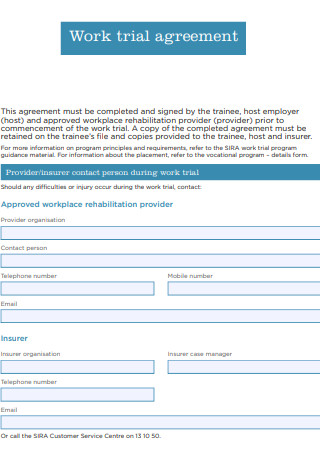
Work Trial Agreement
download now -

Sample Work Trial Agreement
download now -
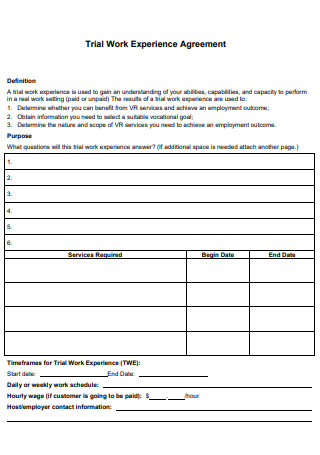
Trial Work Experience Agreement
download now -
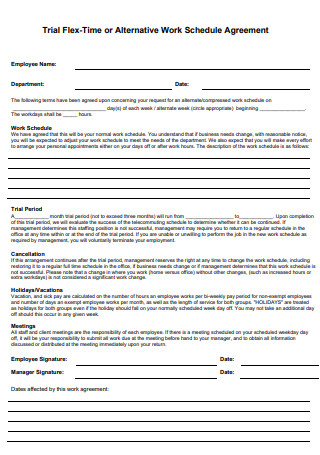
Trial Work Schedule Agreement
download now -
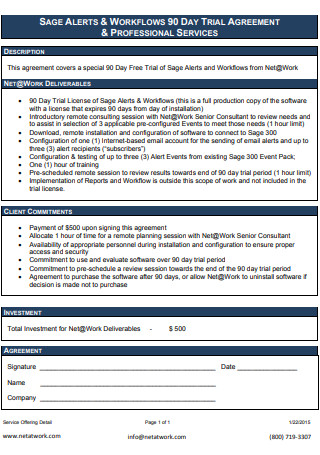
Workflow 90 Day Trial Agreement
download now -
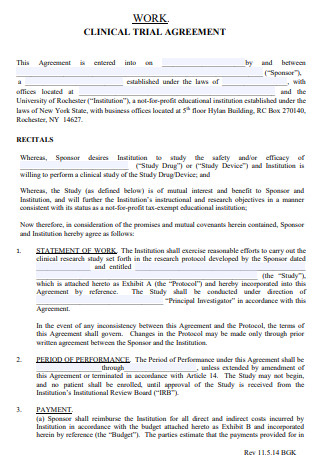
Clinical Work Trial Agreement
download now -
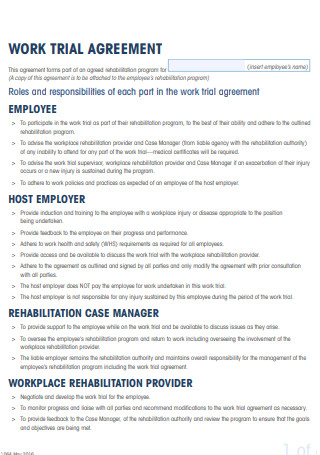
Employee Work Trial Agreement
download now -
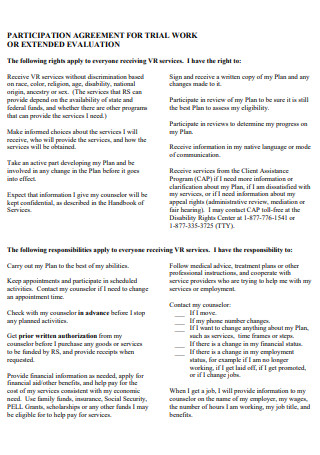
Work Trial Participation Agreement
download now -
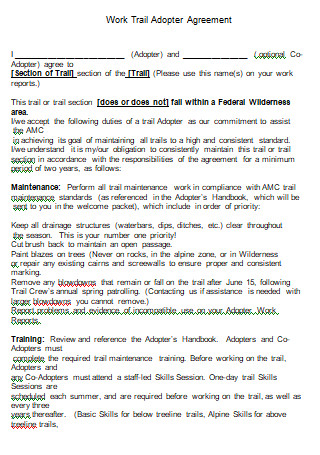
Work Trail Adopter Agreement
download now -
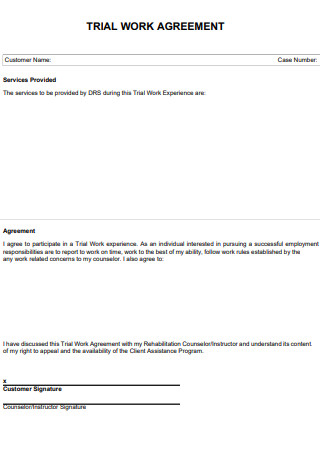
Trial Work Agreement Template
download now
FREE Work Trial Agreement s to Download
9+ SAMPLE Work Trial Agreement
What Is a Work Trial Agreement?
Why Are Work Trial Agreements Important?
What Are the Basic Inclusions of a Work Trial Agreement?
How to Create a Work Trial Agreement
FAQs
What are the common strict rules in a work trial agreement?
What is a trial shift?
Can a trainee quit a work trial?
What Is a Work Trial Agreement?
A work trial agreement is a subcategory of a recruitment procedure wherein companies give job applicants a brief probationary period. This form of arrangement, whether paid or unpaid, is critical to assess whether the candidates for a position can pass the standards set in a work trial period. Also, the work trial agreement should clarify what benefits are different for those who are in a work trial compared to full-time employees. And during the final probationary evaluation, the candidates who perform well will eventually be hired full-time while poor performances lead to rejection.
According to Statista’s 2011 research survey, 78% of US hiring managers agreed that the most important factor in assessing graduates is their area of study, field, or major.
Also, the Employment Agreement Builder (EAB) said that only small businesses, with around 19 or fewer workers, can use work trials. And the trial period may reach up to 90 days as long as the employer and the candidate signed the agreement for it to take place.
Why Are Work Trial Agreements Important?
Work trial agreements can be scary because if you were a candidate in this agreement, you won’t be 100% sure that you will be doing your job permanently. You can either be accepted or replaced afterward. Nonetheless, why is a work trial agreement necessary in business? Here are the top reasons that prove the importance of a work trial agreement:
Easy Reference for Work Trials
A person can promise anything in an oral work trial agreement. But when it comes to a written or printed work trial contract or agreement, there is more strength to the promises mentioned since agreements are legally binding. Once parties sign the agreement, the stipulations written there must be followed. And you won’t forget about every detail from the work trial since the agreement specifies everything from the objectives, tasks, duration, and terms and conditions. Use the document for reference anytime.
Effective Assessment of Potential Candidates
Of course, you can’t forget the fact that a work trial agreement is a useful tool in effectively and efficiently assessing a pool of potential candidates. A trial period is a busy schedule to search for the best candidates to fill a job. Fun fact: 78% of US hiring managers agreed that assessing graduates in their area of study is the most essential factor for assessment. And there is more to expect from the criteria in evaluating applicants out there. Take this opportunity to find out if new hires actually deliver what they promised during interviews.
Engages Candidates to Familiarize the Work
Work trial agreements engage the potential candidates to be introduced to their job ahead. So if ever candidates get the actual job, they don’t need to adjust anymore. It is through this period that candidates themselves discover whether they love the job or fit the qualifications of the job at all. At least employers need not provide long training plans for candidates during actual employment if the applicants already underwent the experience as probees.
Enforcement of Clear and Organized Rules
Just like any binding agreement, a work trial agreement consists of specific and well-arranged rules. The general terms and conditions laid out in a work trial agreement are necessary to have boundaries, limitations, and a clear scope. Without a set of rules, either party may disobey any clause from the agreement without consequences. Hence, be serious in coming up with a work trial agreement, just like how you prepare for an actual employee agreement.
Editable for Different Work Trials
Indeed, mentioning temporary employment or an employee probationary period is often linked with work trial agreements. However, work trials can refer to different types. Other examples include a clinical trial agreement, vocational rehabilitation trial agreement, and lots more. But what matters the most is that the type of trial period or purpose is identified clearly in your agreement.
What Are the Basic Inclusions of a Work Trial Agreement?
There is a basic structure for what work trial agreements look like. And each element in that structure makes up a complete agreement; thus, your final agreement should follow that format too. Although there are slight differences in every agreement’s content, you will often find these inclusions in most work trial agreements:
How to Create a Work Trial Agreement
Some people may overlook the need to produce a well-documented, professionally formatted, or detailed work trial agreement, simply because work trials aren’t official employment contracts yet. However, it must never be taken for granted, especially when the work trial is a bridge to identify the best candidates among the rest. Poorly made agreements may result in conflicts, or worse, not finding the right candidate in the end. So to make a work trial agreement correctly and swiftly, kindly follow these steps:
Step 1: Review Your Company’s Employment Handbook
Take time to conduct business analysis until you can review mainly the regulations and conditions towards work trials and employment. It would be wise that when you already decide to write the work trial agreement, you are already sure of the policies, terms, and details regarding the trial and the whole work itself. Your company’s official handbook of rules and employment will be useful as a reference.
Step 2: Leverage a Sample Work Trial Agreement
The sample work trial agreement templates posted in this article are simply waiting for you. Use these templates to construct the agreement quickly, no need to work from the very beginning. Premade and editable samples are here to lessen the hassle for you. Simply pick a template, edit its content, and produce it in a soft or hard copy. Also, you can leverage loads of options such as a 3-month probation period contract template, trial period employment agreement sample, clinical research trial agreement template, or even a product trial agreement template.
Step 3: Recall the Work Trial Agreement’s Inclusions
Remember the document title, basic information, work duration, and the rest of the elements in a standard work trial agreement, as discussed earlier? Be sure to insert those inclusions in your work trial agreement. Such examples will slowly complete your agreement anyway. And lacking an important inclusion makes your agreement less effective. You can also include more elements as long as they align with your work trial agreement’s statement of purpose.
Step 4: Write in a Formal Tone
A business agreement such as a work trial agreement should be written professionally. That means you write in a formal tone and that you know the appropriate technical terms in writing it. However, you can simplify your content to make it understandable for your audience.
Step 5: Keep Your Data Brief and Specific
There is no need to add flowery words or complex information if they can be simplified. So rather than making your agreement a long detailed letter, be more direct to the point instead. The key is to write succinctly, meaning short yet specific. That will be much easier to read than other types of complicated documents. Finally, fact-check your work and submit it to the appropriate parties once finished.
FAQs
What are the common strict rules in a work trial agreement?
The Employment Agreement Builder (EAB) confirmed that only companies with 19 or fewer employees such as small businesses can use work trials. Also, it is crucial for the agreement to be signed by the parties until the stipulations take effect during the effectivity date. And trial periods may end up to 90 days, depending on what was agreed upon.
What is a trial shift?
A trial shift refers to a monitored on-the-job setup and the trainee in this process is assessed in terms of skills, performance, etc. And this term is commonly used in restaurant businesses and hotel kitchens.
Can a trainee quit a work trial?
Yes, a trainee may quit if the arrangement is not going well. On another note, an employer can also decide for a trainee’s trial to be suspended, especially if poor performance was heavily observed.
A work trial period may be as short as one week or up to 90 days. But one thing is sure, don’t ever take the effort of potential candidates for granted. Carefully monitor the skills, performance, and contributions of these probees until you can come up with a formal decision whether to fully hire specific candidates, train them more, or politely reject them if they performed poorly. And you can make that happen when the work trial agreement you prepared for applicants covers the important inclusions, complete terms, and proper format. Download sample work trial agreement templates now!
